Your Call?
Which of today’s two featured images do you like best, the one made in the sun or the one made when it briefly turned cloudy? Why?
Scroll down to learn how to come up with perfect exposures in sunny and cloudy conditions with any system.
This Just In
Our landline (863-692-0906) has been giving us problems on and off for days. If you have left a message and not heard from us, please get in via e-mail. If you would like to leave a deposit for the first Fort DeSoto IPT, for one or both of the Homer IPTs, or for an In-the-Field session at ILE, please try me on my cell phone at 863-221-2372 and shoot me a text if I do not pick up.
ILE Baby Crane and Eagle In-the-Field Sessions
Right now, I have five tame baby cranes and two baby eagles here at ILE. Timing for a great learning and photo session has never been better. $300 for two solid hours of detailed photographic instruction from this Sunday onwards. We can fine-tune for the best weather. If you are interested in joining me, please get in touch via e-mail.
Galapagos 2023 Opening Filled!
Lake Morton In-the-Field veteran Bob Matyas will be joining the smallest Galapagos 2023 Photo-Cruise of a Lifetime IPT group ever. Why? Two folks signed up for single cabins. This trip is by far the world’s finest photographic cruise of the famed archipelago. I will be returning in August 2024. If you are interested or have questions, please get in touch via e-mail ASAP.
Iceland
My decades-long dream of spending time on Grimsey Island, Iceland, with the puffins — 13 days in this case!, will be realized this coming July. I am doing back-to-back trips as a participant. If anyone would like information on the world’s greatest Iceland/Atlantic Puffin trip this coming July, please contact me via e-mail.
What’s Up?
Based on the weather forecast, I’d guessed that Thursday would have been the better day. Thursday was very good, but Friday was the best day of the year. By far. The shooting strategies this year are far different than they were for the past two seasons. If you are planning a visit soon, you will surely want to sign up and receive the back issues and the very latest Stick Marsh Info. I may be offering a few more In-the field sessions at Stick Marsh in early April.
I was glad to learn the Bear Bob Sabine will be doing both 2024 Kachemak Bay sessions and that IPT veteran Sanjeev Nagrath has left a deposit for the second IPT. Bald Eagle IPT. Please do not hesitate too long if you are thinking of joining me next year in Homer.
Today is Saturday 18 March 2023. I just got back from the lake. It was a Great Egret kind of morning. I spent fifty minutes with a handsome young bird on The Perch II, then did another hunting in the mars. I ended my morning using the 600 f/4 with the 1.4X TC trying for head portraits of the small crane colt using the knee-pod technique. The images are downloading as I type. I located both two-chick families in the South Marsh but drove on by.
This blog post took about more than two hours to prepare and makes three hundred fifty-two days in a row with a new educational post written just for you. Wherever you are and whatever you are doing, I hope that you too have a great day. My plan is to continue to post every day until the streak reaches one year and one day and then begin posting every other day. It won’t be long now!
Please remember to use the B&H and Amazon links that are found on most blog pages and to use the BIRDSASART discount code at checkout when purchasing your new gear from Bedfords to get 3% back on your credit card and enjoy free second-day air FedEx. Please, also, consider joining a BAA IPT. You will be amazed at how much you will learn!
You can find some great photo accessories (and necessities, like surf booties!) on Amazon by clicking on the Stuff tab on the orange/yellow menu bar above. On a related note, it would be extremely helpful if blog-folks who, like me, spend too much money on Amazon, would get in the habit of clicking on the Amazon logo link on the right side of each blog post when they shop online. As you might expect, doing so will not cost you a single penny, but would be appreciated tremendously by yours truly. And doing so, works seamlessly with your Amazon Prime account.
Please remember that if an item — a Delkin flash card, or a tripod head — for example, that is available from B&H and/or Bedfords, is also available in the BAA Online Store, it would be great, and greatly appreciated, if you would opt to purchase from us. We will match any price. Please remember also to use my B&H affiliate links or to earn 3% cash back at Bedfords by using the BIRDSASART discount code at checkout for your major gear purchases. Doing either often earns you free guides and/or discounts. And always earns my great appreciation.
The Stick Marsh Site Guide Subscription Service
The Site Guide Subscription Service was a new concept last year. I e-mailed the first issue in late-March 2022. The Basics e-mail includes specific directions to the site, and a map of the rookery area with specific instructions and wind, weather, and where-to-be advice. Sign up now to receive last year’s five e-mails and tomorrow’s very important update. Unfortunately, things at Stick Marsh are changing very soon.
To sign up for the Stick Marsh Site Guide Subscription Service, call Jim in the office weekday afternoons at 863-692-0906 with your credit card in hand or send a PayPal for the $100.00 to us at birdsasart@verizon.net. Please be sure to include the words Stick Marsh with your PayPal.
I fully understand that you can go to Google Maps, find Stick Marsh, visit, and likely make some good images. You might think, I can do fine just without artie’s advice. But you will do a whole lot better with it. Especially considering the new conditions and the coming change.
B&H
Many folks have written recently stating that they purchased a Sony a1 from B&H and would like their free membership in the Sony 1 Info and Updates Group, a $150.00 value. When I check my affiliate account, their orders have not been there. When I let them know that they get credit for B&H purchases only if they use one of the many B&H affiliate links on the blog or begin their searches with this link, they are always disappointed. If in doubt, please contact me via e-mail and request a BH link. I am always glad to help and to guide you to the right gear.
Bedfords Amazing BAA Discount Policy
Folks who have fallen in love with Bedfords can now use the BIRDSASART coupon code at checkout to enjoy a post-purchase, 3% off-statement credit (excluding taxes and shipping charges) on orders paid with a credit card. The 3% credit will be refunded to the card you used for your purchase. Be sure, also, to check the box for free shipping to enjoy free Second Day Air Fed-Ex. This offer does not apply to purchases of Classes, Gift Cards, prior purchases.
Visit the Bedfords website here, shoot Steve Elkins an e-mail, or text him on his cell phone at (479) 381-2592.
Money Saving Reminder
Many have learned that if you need a hot photo item that is out of stock at B&H and would like to enjoy getting 3% back on your credit card along with free 2nd Day Air Fed-Ex Air shipping, your best bet is to click here, place an order with Bedfords, and enter the coupon code BIRDSASART at checkout. If an item is out of stock, contact Steve Elkins via e-mail or on his cell phone at (479) 381-2592 (Central time). Be sure to mention the BIRDSASART coupon code and check the box for Free Shipping. That will automatically upgrade to free 2nd Day Air Fed-Ex. Steve has been great at getting folks the hot items that are out of stock at B&H and everywhere else. The waitlists at the big stores can be a year or longer for the hard-to-get items. Steve will surely get you your gear long before that. For the past year, he has been helping BAA Blog folks get their hands on items like the SONY a 1, the SONY 200-600 G OSS lens, the Canon EOS R5, the Canon RF 100-500mm lens, and the Nikon 500mm PF. Steve is personable, helpful, and eager to please.
Important Note
As an Amazon Associate, I earn a small percentage when you purchase from Amazon after using any of the Amazon links on the blog (including the logo-link on the right side of each blog post page). My affiliate link works fine with Amazon Prime and using it will not cost you a single cent. Huge thanks, BTW 🙂


Gear Questions and Advice
Too many folks attending BAA IPTs and dozens of photographers whom I see in the field and on BPN, are — out of ignorance — using the wrong gear, especially when it comes to tripods and more especially, tripod heads. And the same is true in spades when ordering new camera bodies or lenses. My advice will often save you some serious money and may help you avoid making a seriously bad choice. Please know that I am always glad to answer your gear questions via e-mail. If you are desperate, you can try me on my cell at 863-221-2372. Please leave a message and shoot me a text if I do not pick up.
|
|
|
This image was created on 18 March 2023 on a Stick Marsh In-the-Field Workshop in Fellsmere, FL Seated on a pillow, employing the knee-pod rest position, I used the handheld BLUBB-supported Sony FE 400mm f/2.8 GM OSS lens and The One, the Sony Alpha 1 Mirrorless Digital Camera). The exposure was determined via Zebra technology with ISO on the Thumb Dial. ISO 640. 1/5000 sec. at f/2.8 (wide-open) in Manual mode. When evaluated in RawDigger, the exposure was determined to be perfect (ho hum). AWB at 8:00:00am on then sunny morning. Tracking: Zone AF-C with Bird Face/Eye detection enabled performed to perfection. Be sure to click on the image to enjoy a high-res version. Image #1: Roseate Spoonbill landing in full sun |
Dealing With Constantly Changing Light
With some broken cloud cover to the east, the light was changing almost constantly. One minute you would set the exposure for bight sun, the next minute you had to decrease the shutter speed and raise the ISO when a cloud covered the sun. On the drive back to ILE yesterday after our great Stick Marsh morning, Mike Gotthelf asked if there were a better way to come up with good exposures in constantly changing light.
The answer is “No.”
If you work in any automatic mode with AUTO ISO — Shutter Priority would be best, it is not possible to change the Exposure Compensation quickly enough as the background changes from dark green mangrove reflections to sunlit water (or sky).
Keep on reading to learn the best approach with any system.
|
|
|
This image was created on 18 March 2023 on a Stick Marsh In-the-Field Workshop in Fellsmere, FL Seated on a pillow, employing the knee-pod rest position, I used the handheld BLUBB-supported Sony FE 400mm f/2.8 GM OSS lens and The One, the Sony Alpha 1 Mirrorless Digital Camera). The exposure was determined via Zebra technology with ISO on the Thumb Dial. ISO 1250. 1/3200 sec. at f/2.8 (wide-open) in Manual mode. When evaluated in RawDigger, the raw file brightness was determined to be dead-solid perfect (ho hum). AWB at 8:02:27am on then cloudy morning. Tracking: Zone AF-C with Bird Face/Eye detection enabled performed to perfection. Be sure to click on the image to enjoy a high-res version. Image #2: Roseate Spoonbill landing after a cloud covered the sun |
Determining Exposures with Sony
Both images were created at the wide-open aperture: f/2.8. Image #1 was created with a shutter speed of 1/5000 second at ISO 640. Image #2 was created at ISO 1250 with a shutter speed of 1/3200 sec. If my math is correct, Image #2 was created using 1 2/3-stops more light than Image #1.
After setting the shutter speed to 1/5000 second, the sunny spoonbill exposure was determined by pointing the lens at an incoming spoonie and raising the ISO until faint Zebras were present on the back of the neck, the brightest part of the bird. RawDigger showed these exposures to be either perfect or dead-solid perfect.
Then came the cloud. So, how did I get to the right exposure? Using Sony, it was relatively easy to come up with the cloudy spoonbill exposure. When the cloud covered the sun, I pointed the lens at a spoonbill on the ground, decreased the shutter speed from 1/5000 to 1/3200 second (to let in 2/3-stop more light), and doubled the ISO from 640 to 1250 (to let in an additional stop of light). At that point, Zebras appeared on the bird’s neck. Another perfect exposure. Note: RawDigger showed 1,788,000 OvExp pixels for Image #2 with all of the over-exposure on the sky, just what I need to come up with a dead-solid perfect exposure for the subject.
Determining Exposures with Other Systems
Folks using Nikon or Canon or any other system that I am aware of are not blessed with Zebra technology for stills. For those folks, coming up with the right exposure is a bit more difficult and a bit more time-consuming. It is best done by creating a test image and then evaluating the histogram. And yes, that needs to be done every time that the light changes.
In-Camera Histograms
With all systems, the in-camera histograms are poor at best for those who wish to create perfectly exposed to the right raw files. At times that show over-exposed highlights when there are none, and at times they show no data at all anywhere near the right side of the histogram yet there are millions of over-exposed pixels.
Saving Time With Any System
Whatever gear you are using, here is a time-saving tip to use when working in changing light. Once you have a good sunny exposure for a given subject, point your lens at the water (or any other large, consistently-toned area), and note the reading on the analogue scale. Yesterday, in full sun, that showed +2/3-stop. With the sun behind a cloud, +2-stops was pretty much perfect. As noted here previously on many occasions, the most sophisticated metering systems are pretty smart when the sun is out at full strength, and very dumb in low light conditions. And the lighter toned the backgrounds, the dumber they are. All of the above is true whether you are using Canon’s Evaluative metering, Nikon’s Matrix metering, or Sony’s Multi-metering.
If you really want to learn exposure get yourself a copy of the RawDigger-Guide and then sign up for an IPT ASAP.
Hard Work
Yes, getting the right exposure in constantly changing light is hard work. It requires study, skill, and knowledge. It requires concentration and attention to detail. And mental stamina.
|
|
|
Fort DeSoto in spring is rife with tame birds, many in full breeding plumage. Click on the composite to enjoy a larger version. Clockwise from upper left around to center: Laughing Gull landing on head of Brown Pelican, Laughing Gull in flight, Reddish Egret sunrise silhouette, Great Blue Heron with needlefish, Yellow-crowned Night Heron with ghost crab, Roseate Spoonbill, Sanderling in breeding plumage, and white morph Reddish Egret in glorious breeding plumage. |
The 2023 Spring Fort DeSoto Instructional Photo Tours (IPTs)
Spring Fort DeSoto IPT #1: Tuesday 28 March through the morning session on 31 March 2023. 3 1/2 Days: $1899.00 includes three working brunches. Limit six photographers/Openings: five.
Spring Fort DeSoto IPT #2: Tuesday 11 April through the morning session on 14 April 2023. 3 1/2 Days: $1899.00 includes three working brunches. Limit six photographers/Openings: four.
Spring Fort DeSoto IPT #3: Tuesday 9 May through the morning session on 12 May 2023. 3 1/2 Days: $1899.00 includes three working brunches. Limit six photographers. /Openings: five.
Fort DeSoto, located just south of St. Petersburg, FL, is a mecca for terns and gulls, wading birds, and shorebirds in spring. Many of the birds will be in full breeding plumage. Simply put, DeSoto is the new Ding Darling. Migrant shorebirds are in abundance, and many are exceedingly tame. We should have great chances on Royal and Sandwich Terns and both white- and dark-morph Reddish Egrets. Great Egret, Snowy Egret, Great Blue Heron, Tricolored Heron, and White Ibis are easy as well and we will almost surely come up with a tame Yellow-crowned Night-Heron or two along with some American Oystercatchers. We will enjoy lots of great flight photography, especially with the Brown Pelicans.
|
|
|
Again, Fort DeSoto in spring is rife with tame birds, most in breeding plumage. Click on the composite to enjoy a larger version. Clockwise from upper left around to center: Laughing Gull in flight, Yellow-crowned Night-Heron, Sandwich Terns copulating, Roseate Spoonbill, Great Egret with reflection, breeding plumage Short-billed Dowitcher, American Oystercatcher, Royal Tern, white morph Reddish Egret, and Snowy Egret in marsh. |
In Addition!
We should also get to photograph a variety of other shorebirds including Black-bellied, Semipalmated, Wilson’s, Snowy, and Piping Plovers, Willet, Dunlin, Short-billed Dowitcher, Marbled Godwit, and most especially, Red Knot, with many individuals in their handsome breeding plumages. In spring the T-shaped peninsula and the newly formed sandbar, Outback Key, are literally packed with avian treasures.
With just a bit of luck, we may get to photograph one of Florida’s most desirable species: Roseate Spoonbill. And we will surely get to do some Brown Pelican flight photography. With luck, they will have Laughing Gulls landing on their heads. And though not guaranteed, Wood Stork might well be expected. And we will be on the lookout for a migrant passerine fallout in the event of a thunderstorm or two.
|
|
|
Yes, Fort DeSoto in spring is rife with tame birds, most in breeding plumage. Click on the composite to enjoy a larger version. Clockwise from upper left around to center: breeding plumage Dunlin, dark morph Reddish Egret displaying, Laughing Gull vertical front-end portrait, Laughing Gull with prey item, landing on head of Brown Pelican, breeding plumage Royal Tern displaying, Royal Terns — pre-copulatory stance, Laughing Gulls copulating, Laughing Gull head portrait, breeding plumage Sandwich Tern with fish, and a rare treat, a breeding plumage White-rumped Sandpiper. |
What You Will Learn on a DeSoto IPT
- 1- The basics and fine points of digital exposure; how to get the right exposure every time after making a single test exposure (or before if you are using SONY gear).
- 2- How and why to work in Manual mode (even if you’re scared of it).
- 3- How to approach free and wild birds without disturbing them.
- 4- Lots about bird behavior and how to use that knowledge to help you create better images.
- 5- To age and identify many species of shorebirds including various sandpipers, plovers, dowitchers, and possibly yellowlegs.
- 6- To spot good situations and to choose the best perspective.
- 7- To see, evaluate, and understand the light.
- 8- To design pleasing images by mastering your camera’s AF system.
- 9- And perhaps most importantly, to evaluate wind and sky conditions and understand how they affect bird photography.
- 10- More than you could ever imagine.
|
|
|
You got it by now! Fort DeSoto in spring is rife with tame birds, most in breeding plumage. Click on the composite to enjoy a larger version. Clockwise from upper left around to center: Roseate Spoonbill, immature Brown Pelican in flight, the heron/egret hybrid, American Oystercatcher feeding, immature Royal Tern on railing, Great Egret morning silhouette, Black Skimmer in surf, and underside head portrait of Great Blue Heron. |
The Details
Morning sessions will run two and one-half to three hours; afternoon sessions about two. There is never a set schedule on an IPT — we adapt to the conditions. On cloudy mornings with the right wind, we may opt to photograph till noon and skip the afternoon session. That especially when the afternoon weather is looking iffy. We may opt to visit a great North Tampa rookery if conditions warrant that.
There will be a Photoshop/Image Review session before and after brunch (included) each of the three full days. That will be followed by Instructor Nap Time. Each of these IPTs will run with only a single registrant as I do not like disappointing anyone. The best airport is Tampa (TPA). Once you register, you will receive an e-mail with lodging information. Do know that it is always best if IPT folks stay in the same general area (rather than at home or at a friend’s place a good distance away).
Folks attending this IPT will be out in the field as early as possible and stay out late to take advantage of sunrise and sunset colors; this is pretty much a staple on almost all BIRDS AS ART Instructional Photo-Tours. Doing so will often present unique photographic opportunities, opportunities that will be missed by those who need their beauty rest and those who need to get home for a proper dinner. I really love it when I am leaving the beach at 9:30am on a sunny morning after a great session just as a carful or two of well-rested photographers are arriving … We will be getting wet.
Your $599 deposit is due now. Credit cards are OK for that. You can register by calling Jim or Jennifer during weekday business hours at 863-692-0906 with a credit card in hand. Once you leave a deposit, you will receive an e-mail with your balance statement and instructions for sending your balance check three months before the trip begins. If you wish to pay in full right off the bat, you can make your check out to BIRDS AS ART and send it via US mail here: BIRDS AS ART, PO BOX 7245, Indian Lake Estates, FL 33855. You will receive a confirmation e-mail with detailed instructions, and clothing and gear advice two months before the trip. Please shoot me an e-mail if you plan to register or if you have any questions.
IPT veterans and couples or friends signing up together may e-mail for discount information.
Typos
With all blog posts, feel free to e-mail or to leave a comment regarding any typos or errors.


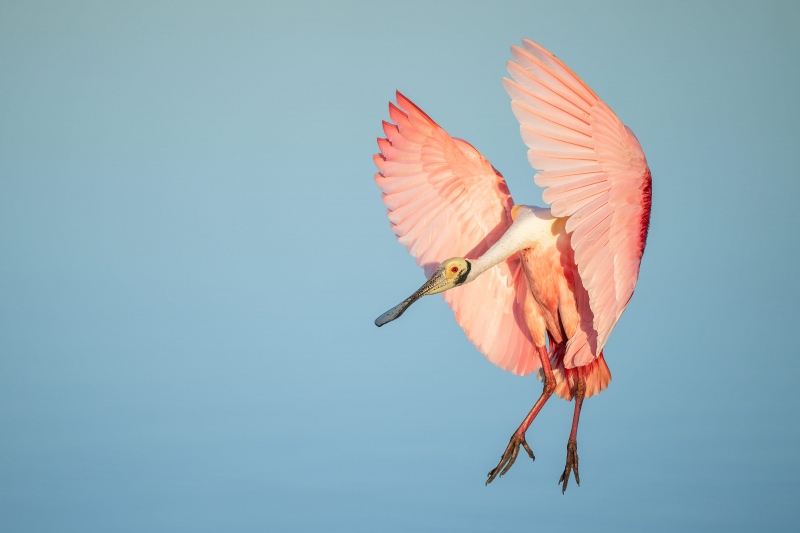
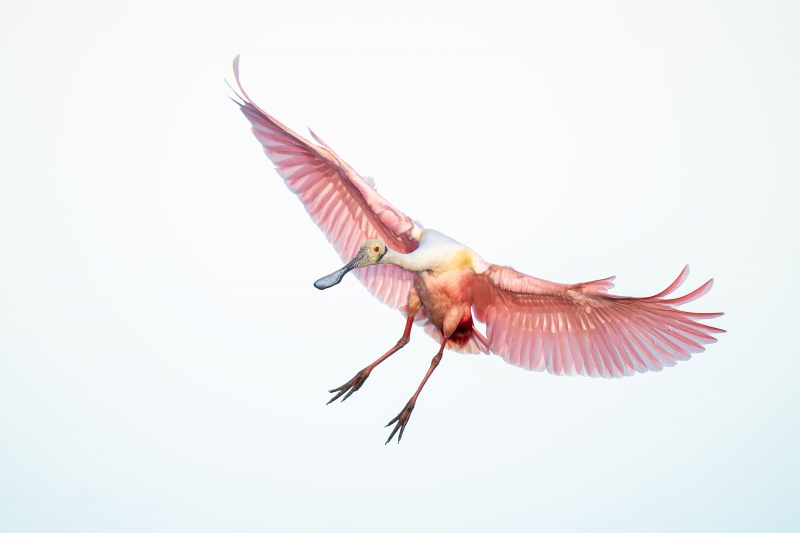
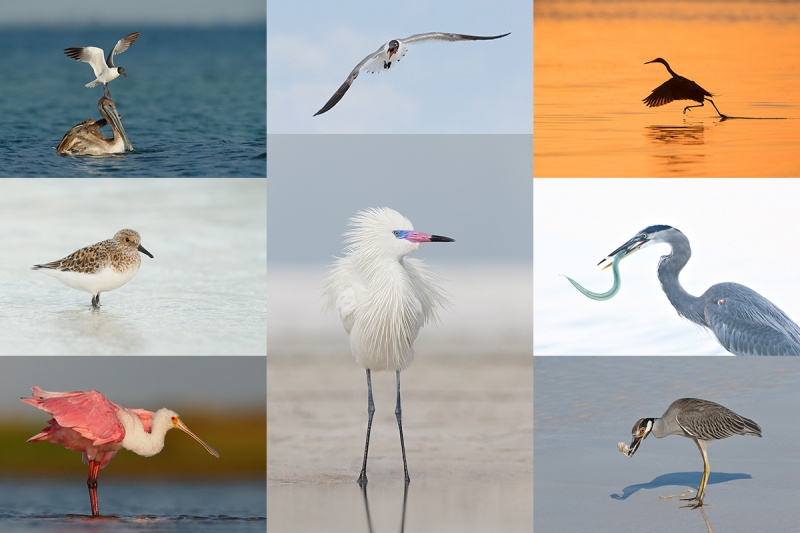
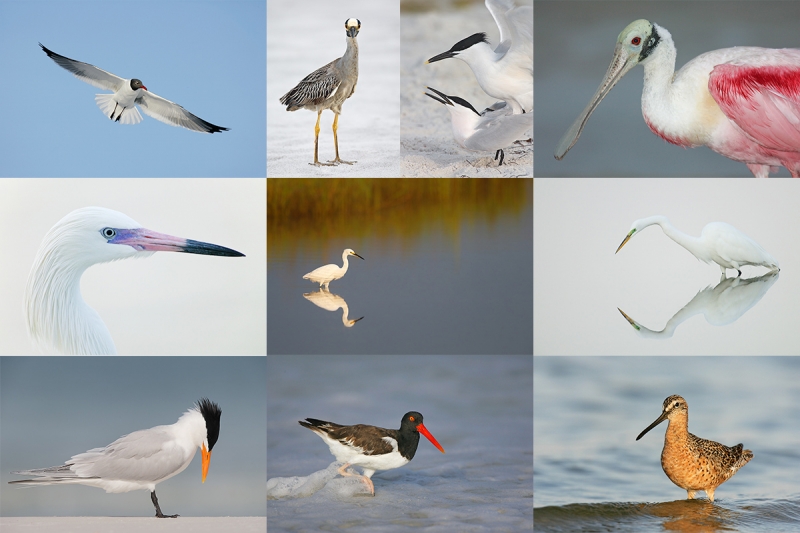
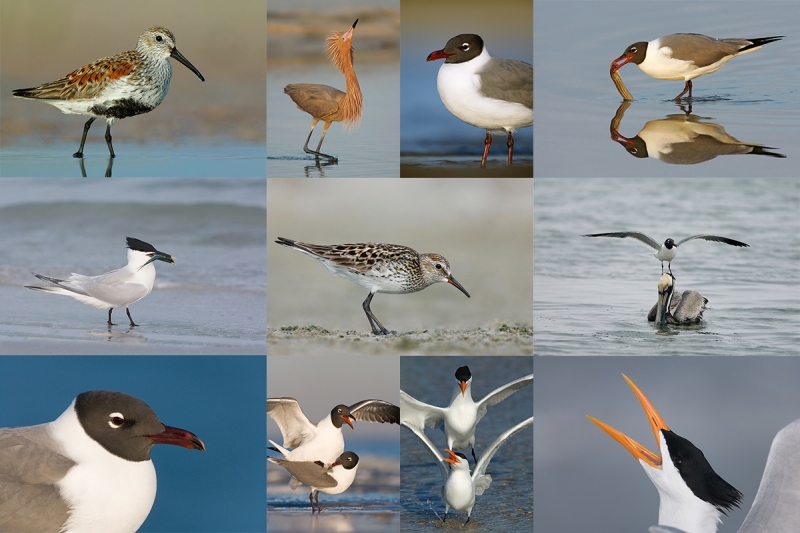
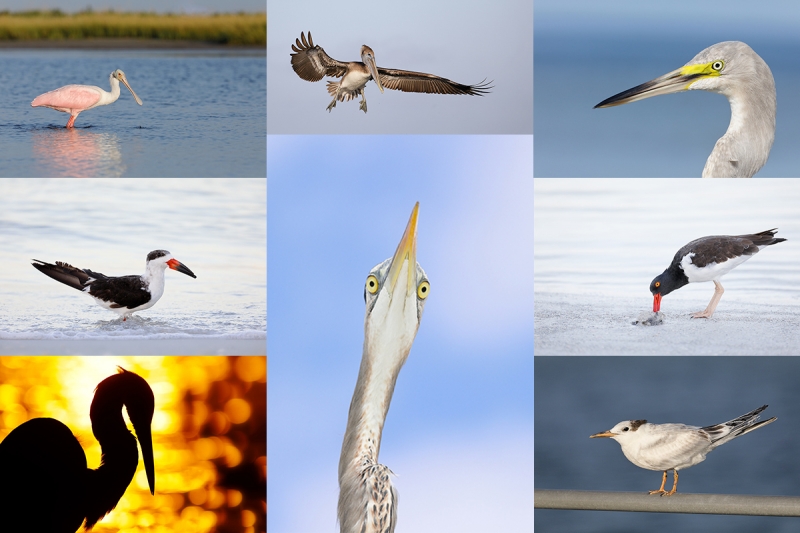













Definitely Image No. 2 is preferred, as many above have noted, due to the lack of shadows.
Hard to choose. At first glance…and second … Really like the blue sky complimenting the pink spoonbill. So I guess #1.
I can’t choose because I like the lighting better in 2 making the pink more delicate than in 1. Also 2 doesn’t have harsh shadows as in 1. I also like the wing position better. In 2 the gap between wing and tail grabs my eye and I have to keep figuring out what that white gap is.
I prefer #2 because the lighting is less harsh
Artie, #2 wins hands down.
I’ve gotten sensitive to shadows, so much prefer Image #2, noting that while the sky there is already somewhat blue, saturation could be turned up, if desired, to get closer to the colors of Image #1. One of the great things about digital is being able to shoot with muted or absent sunlight.
Hi, Artie. I much prefer image 1. I like the rich saturated colors on the bird and I much prefer the blue over the white sky.
Image #1 and #2 of Roseate Spoonbill are both good and interesting. Image #2 is not too dark!
It appears you’re liking the 400 f/2.8 more and more! With respect to the two images, of course image one offers better color and feather detail and the wing position is more appealing. The neck and particularly head shadow are less desirable. The second image obviously lacks the aforementioned characteristics though the head/neck shadow are less prominent. Given the sky, wing pose, and colors are better in 1, I favor it in spite of the issues.